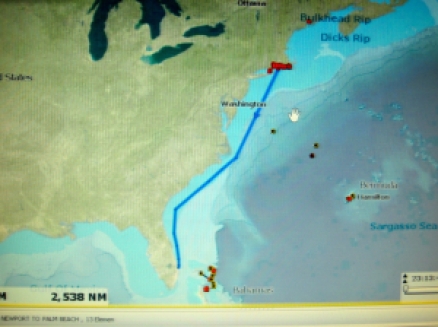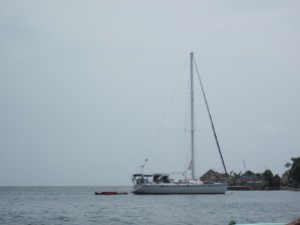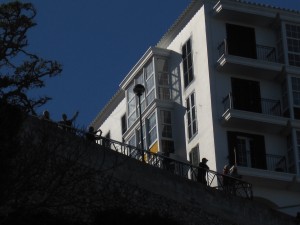Sailing Dharma
Here is my first experiment with the new GoPro Hero 3 Black edition. The protagonist is Dharma and her crew sailing downwind at 10kts average flying only the yankee in 25kts of wind.
Enjoy
Here is my first experiment with the new GoPro Hero 3 Black edition. The protagonist is Dharma and her crew sailing downwind at 10kts average flying only the yankee in 25kts of wind.
Enjoy
Michele and I share the same dream but follow two very different paths. I chose to refit an old slow monohull. He is building a light and fast trimaran from scratch. In both cases the vessels have the purpose to provide their owners with just enough comfort to sail the seas and live aboard.
Michele and I were introduced by a common connection and started a conversation online. It’s a great sprint for your motivation when you find someone with whom discuss your projects. Especially when your dream makes you feel like a weirdo among the people that surround you. That’s why the conversation became so intense and we shared a lot of our ideas and experiences about sailing and living aboard.
Sailing has always been in Michele’s DNA. He moved his first steps on Optimists, then he attended to sailing school. He continued to self-educate himself through a lot of miles sailed with his father on a formula 28 and 36 catamaran, and helping in building those boats.
Recently he thought of make sailing more than a hobby. He intends to get the necessary licenses and start to work as skipper for charter boats, deliveries and teaching sailing.
Michele began the building of his trimaran three years ago, but it’s just recently that Michele is pushing harder as the project looks closer to an end. The 22ft boat named “Trimaranga” is taking shape in an empty warehouse in Bologna that his uncle decided to make available for the project. He says it’s about 70% completed but remains cautious about the final date. As we know very well, it’s hard to make plans with boats.
One thing is for sure: both Michele and I like to dream.

The trip will be long, roughly 1000 nautical miles. The idea is to make stops along the way in places like Turks and Caicos, Dominican Republic, St.Thomas. With a crew of 4 we prefer to do short legs and hide from the worst blows of the trades that are at their maximum in this season.

It looks like we are finally ready for a yacht delivery to Florida, . A series of negative and sad events plus some bad weather coming up delayed our departure. Now all is set for a departure on Sunday morning.
Newport has been my home for this summer but the winter is about to kick in for real now. I experienced the first cold of the season and I’ve been missing the sunny, long summer days that make this place so beautiful. But most important jobs are heading south as well, and a yacht delivery is the best way to move where the jobs are.
Yachts move towards warm weather and sunny days as birds and other migratory specimen do. The hurricane season is close to its end (1st of November according to insurance companies) and the Carribean is attracting all the boats from NE of the United States and the Mediterranean with the promise of sun, white beaches and crystal waters. Another busy winter season, despite the financial crisis.
Same does Paraiso, a 108 ft Sailing Yacht where I’ve been working a lot this summer, cleaning bilges, washing and polishing the hull, polishing stainless steel, climbing masts, fixing electrical connections… A lot of work.
Now the mission is to sail down to West Palm Beach, FL where she is going to receive her make-up before the Carribean.
With a crew of 5 we are sailing the distance of 700 nm into the Gulf Stream. She is the biggest and more comfortable sailing yacht I’ve ever been and the trip will take approximately 4 days. Fully prepared food, drinks, snack and hot shower will comfort our long hours on watch.
This is a montage of pictures and videos of my job in San Blas Islands aboard Andiamo.

I took three hours of my free time to fulfill a desire I had since the very first moment I arrived in Guna Yala. Everyday, you can see the shapes of Gunas on their sailing ulu, setting sail at the first light in the morning and heading for the fishing destinations or to the mainland.
This image always inspired me a deep sense of freedom and satisfaction and an intense desire to sail one.

Cayuco is the name the Spanish explorers gave to the dugout canoes built by indigenous people of the Antilles and other American regions. It describes a monohull with flat bottom and no keel or daggerboard, propelled and steered by a wide paddle. In Guna language it is called “Ulu”, or “urmor”, ù but they often use the name cayuco, at least with non-Gunas like me.
Cayucos are built with the dugout technique: this means that the hull is shaped by carving a log of suitable dimensions, usually mahogany which grows in the well preserved forest of the Comarca (indigenous territory) . Similar to other canoe designs the bow and stern are pointy, and have a streamlined skeg, that help them tracking in the water.
Looking at the bilge you notice the rough marks left by the tools during the chipping out. It is remarkable how Guna shipwrights can obtain such a regular shape with this method and the amount of labor behind every single piece must be enormous.
In Guna Yala cars are useless and the transportation happens on water. Cayucos are everywhere, and sometimes it is hard to find docking to the main piers. They come in very different size and dimensions, every family has at least a small paddle one, but sailing cayucos are longer and more expensive. The modernity brought outboard engines and fiberglass boats named “pangas” or the more common spanish name “lancha”.
The cayuco Dino and I sailed is owned by one of his cousin. The man told me that it was built from a tree donated by his father. When his father died he had the permission to cut the tree and have it carved and painted.
On the sailing ulu the rig is a spritsail (similar to an Optimist): the mainsail is attached with a loose foot to a boom, and the “sprit” is a spar that support the leech. The main is sheeted to a hole through the gunwale and tied with a simple knot. The boat comes also with a headsail which is set flying from the bow to the mast head. The simplicity of the construction is a demonstration of how little techonology is really needed to sail. Even if a lot can be done to improve the performance of this system, it is enough for the essential living of the Kunas, and I am still amazed about how good it is the windward performance without a centerboard. You just need to be equipped with a lot of patience, a skill which Kunas culture is rich of.


The rudder is substituted by a wide paddle, called cammi. In fact, the helmsman can be very much called a paddler as you need to paddle the boat into the wind in order to tack. It took me a while to understand how to steer the sailing ulu with a wooden paddle and the fuzzy wind of the afternoon was not helping, but it was nothing too complicated. There is definitely a more close feeling of how the rudder operates and the forces that act on it using this technique rather than turning the wheel of a performance cruiser.

As often happens during fishing trips, especially the ones you improvise, we didn’t catch any fish. Nonetheless I had an interesting day on a sailing ulu, I learned about traditional crafts and fulfilled a little dream of mine. I hope I am going to do it again, next time I hope with a bigger sail, just to have more speed sensation and capsizing danger.
How to describe San Blas? I’ve been spending aproximately 2 weeks in my new adventure aboard SV Andiamo and I’m still without words. I noticed one sure fact: visitors going crazy about their sailing experience here.

First I have to explain where we are. It’s Panamà, the fastest growing economy in Central America. It’s Panama City with new buildings appearing everyday, traffic and good restaurants, malls and signs that invite you to come and invest or retire here. The skyline is amazing, something I’m not used to as I’m from Europe and that’s the reason why Casco Viejo, the old colonial zone is more familiar to me.
But San Blas has nothing to do with Panama City, we’re at the antipodes. The separation is provided by a wide stripe of virgin forest still unexplored in some of its parts. After the forest the coast and and the islands, more than 370, sometimes just few centimeters of sand with palm trees. We are in the home of Kunas, the indigenous that own and administrate this region, with their own laws and traditions. Paddling or sailing on their dugout they move from and to the coast carrying water, food, people.approaching the boat to sell lobsters, crabs or fish, or the Molas, traditional and really artistics handicrafts made by Kuna women.
And that’s the other world, the world of wise Kunas, ancient traditions and deep respect for natural environment that gives us a wonderful scenario to sail and relax. It’s more than a postcard, it’s life!

After two false starts (never ever use a Max Prop or similar foldable propeller for very long sailing) we finally left Willemstad for a three days sailing up to Boca Chica, Dominican Republic and we moored in a lovely marina just before some more squalls hit the area.

We had good winds for the first part of the trip and then we had to use the engine for almost half of the time. That was another good test that the old Perkins 4.236 passed with some questions. Is the injection in order? Why is overheating some times and some others not? A good mechanic here in Dominican Republic could be a precious help for these doubts.
We’re still in doubt about our future steps. Everything depends on the boat overall conditions and of course on the meteo. It is possible that we need three more days in Dominicam Republic to get everything we need for the next leg, the strongest one. From here if the weather will let us we would like to go up to Bermudas and then Azores.
I’ll try to keep a record of the next steps, in the meanwhile I start publishing some pictures of the trip.
Abbiamo toccato i porti di Puerto Colom (città fantasma da evitarsi e marina carissima!) Altea, Cartagena e poi diretti fino a Gibilterra, per un totale di 1270 miglia nautiche circa da Malta a Gibilterra.
